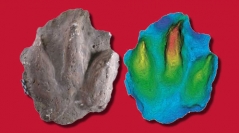

 Geodiversitas
46 (8) - Pages 343-366
Geodiversitas
46 (8) - Pages 343-366The coastline of Le Veillon (western France) has become a key tracksite for the study of Early Jurassic archosaurs from Europe since the second half of the 20th century. Amongst the thousand dinosaur footprints recovered from this locality, some tracks became historical and ichnotaxonomical comparative references in many studies. However, the type material from Le Veillon has never been revised. Here, we reinvestigate the type specimens from Albert-Félix de Lapparent’s collection using morphometry and 3D imaging photogrammetry. Amongst the eight ichnospecies historically created at Le Veillon, only two are considered valid, i.e. Grallator olonensis Lapparent & Montenat, 1967 and Grallator variabilis Lapparent & Montenat, 1967. “Batrachopus gilberti” Lapparent & Montenat, 1967, “Eubrontes veillonensis” Lapparent & Montenat, 1967 and “Grallator maximus” Lapparent & Montenat, 1967 are subjective junior synonyms of Batrachopus deweyi (Hitchcock, 1843) Hitchcock, 1845, Eubrontes giganteus Hitchcock, 1845 and Grallator minusculus (Hitchcock, 1858) Demathieu, Gand, Sciau & Freytet, 2002, respectively. The ichnogenus “Talmontopus” Lapparent & Montenat, 1967 is a subjective senior synonym of Kayentapus Welles, 1971, and its type ichnospecies (“T. tersi” Lapparent & Montenat, 1967) is regarded as a nomen dubium. “Anatopus” Lapparent & Montenat, 1967 (and its type ichnospecies “A. palmatus” Lapparent & Montenat, 1967) and “Saltopoides” Lapparent & Montenat, 1967 (and its type ichnospecies “S. igalensis” Lapparent & Montenat, 1967) are considered as nomina dubia. The tracks initially ascribed to Dahutherium Montenat, 1968 are here reinterpreted as Batrachopus isp. and indeterminate grallatorid tracks. The ichnoassemblage from Le Veillon is more similar to tracks from the Grands Causses area (southern France) than to any other Lower Jurassic ichnoassemblage in Europe. Although contemporaneous body fossils remain unknown in Vendée, the archosaur tracks from Le Veillon confirm the co-occurrence of crocodylomorphs and theropods in littoral environments from the central part of Laurasia during the Hettangian.
Theropod footprints, crocodylomorph tracks, Hettangian, Talmont-Saint-Hilaire, Vendée